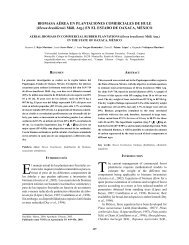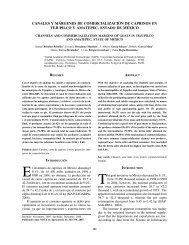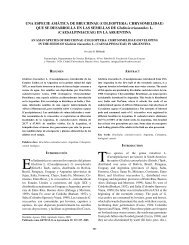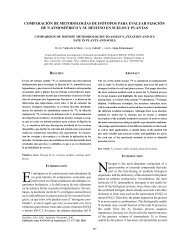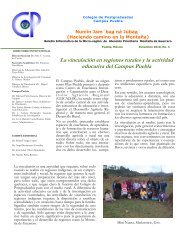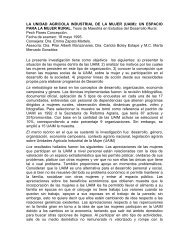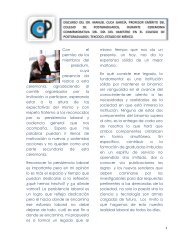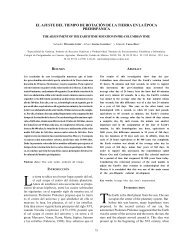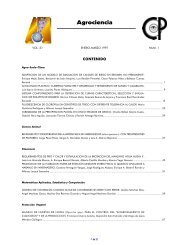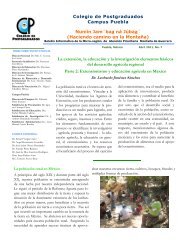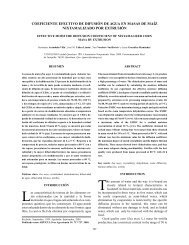AUTO-ACLAREO Y GUÍAS DE DENSIDAD PARA Pinus patula ...
AUTO-ACLAREO Y GUÍAS DE DENSIDAD PARA Pinus patula ...
AUTO-ACLAREO Y GUÍAS DE DENSIDAD PARA Pinus patula ...
You also want an ePaper? Increase the reach of your titles
YUMPU automatically turns print PDFs into web optimized ePapers that Google loves.
<strong>AUTO</strong>-<strong>ACLAREO</strong> Y <strong>GUÍAS</strong> <strong>DE</strong> <strong>DE</strong>NSIDAD <strong>PARA</strong> <strong>Pinus</strong> <strong>patula</strong> MEDIANTE EL ENFOQUE <strong>DE</strong> REGRESIÓN <strong>DE</strong> FRONTERA ESTOCÁSTICA<br />
árbol, ln indica el logaritmo natural, y son los parámetros a<br />
estimar y es el término de error en el modelo.<br />
Modelos de regresión de frontera estocástica (RFE)<br />
Los modelos de regresión de frontera estiman los valores<br />
extremos de un conjunto de datos, en lugar de la media o los<br />
cuantiles de una función. En el método estocástico, la propia<br />
frontera es una variable aleatoria de manera que cada observa-<br />
ción tiene su propia función frontera que se desvía de la fun-<br />
ción general. La ventaja de este enfoque es considerar que la<br />
frontera puede ser consecuencia de factores externos no medi-<br />
dos. El modelo de frontera estocástica divide el componente de<br />
error en: 1) un componente de error asociado con la medición<br />
de las observaciones individuales (v i ) y 2) un componente de<br />
error que se asume para dar cuenta de la ineficiencia técnica<br />
en los datos (u i) (Kumbhakar y Lovell, 2000; Cummings et al.,<br />
2001).<br />
La forma del modelo de RFE, según Aigner et al. (1977) es:<br />
La estructura del error es:<br />
yi = f ( xi;<br />
β)+ ε i<br />
(4)<br />
i v i u i , i1,..., N.<br />
donde y i es la producción (output), x i es un vector (k1) de can-<br />
tidades de entrada (input), es el vector de parámetros desco-<br />
nocidos, v i es una perturbación simétrica distribuida indepen-<br />
dientemente de u i . Ésta recoge las variaciones aleatorias en la<br />
producción debido a factores como errores aleatorios, errores en<br />
la observación y medida de los datos, y se supone que se distribuye<br />
iid N 0 v<br />
2 ( , σ ) ; el componente ui es un término asimétrico<br />
que recoge la ineficiencia técnica de las observaciones y se supone<br />
que se distribuye independientemente de v i y de los regresores.<br />
Por tanto, hay que seleccionar distribuciones estadísticas para u i ,<br />
que se distribuyan para un solo lado, como en el caso de la semi-<br />
normal y la exponencial (Brescia et al., 2003; Zhang et al., 2005).<br />
Si el valor de la ineficiencia técnica u i se asume como<br />
cero, lo cual es menos probable con valores crecientes de ui ,<br />
+<br />
entonces el modelo iid N ( 2<br />
0,σ u ) se refiere al modelo Halfnormal.<br />
Si los ui (i1...N) son variables aleatorias no negativas<br />
+<br />
iid N ( 2<br />
µσ , u ) , entonces el modelo se conoce como el modelo<br />
Truncated-normal (en cero) (Kumbhakar y Lovell, 2000).<br />
Las técnicas de máxima verosimilitud se usan para estimar la<br />
frontera y el parámetro de la ineficiencia. El término de in-<br />
eficiencia, u i , es de interés en econometría. Si los datos están<br />
en el espacio logarítmico, u i es una medida del porcentaje en<br />
The SFR model form according to Aigner et al. (1977) is:<br />
The structure of the error is:<br />
yi = f ( xi;<br />
β)+ ε i<br />
(4)<br />
i v i u i , i1,..., N.<br />
where y i is the output, x i is a vector (k1) of input quantities,<br />
is the vector of unknown parameters, v i is a symmetric<br />
perturbation distributed independently of u i . This includes<br />
random variations in output due to factors such as random<br />
errors, errors in the observation and measurement of data, and is<br />
supposed to be distributed iid N 0 v<br />
2 ( , σ ) ; the component ui is an<br />
asymmetric term that incorporates technical inefficiency of the<br />
observations and is assumed to be distributed independently of<br />
v i and the regressors. Therefore, it is necessary to select statistical<br />
distributions for u i, to be distributed on one side only, as in the<br />
case of the semi-normal and the exponential (Brescia et al., 2003,<br />
Zhang et al., 2005).<br />
If the value of technical inefficiency u i is assumed to be<br />
zero, which is less likely with increasing values of ui, then the<br />
+<br />
model iid N ( 2<br />
0,σ u ) refers to the model Half-normal. If ui +<br />
(i1...N) are nonnegative random variables iid N ( 2<br />
µσ , u ) ,<br />
then the model is known as the Truncated-normal model<br />
(zero) (Kumbhakar and Lovell, 2000). Maximum likelihood<br />
techniques are used to estimate the frontier and the<br />
inefficiency parameter. The inefficiency term ui is of interest<br />
in econometrics. If the data are in logarithmic space, u i is a<br />
measure of the percentage by which a particular observation<br />
can not reach the estimated frontier. To model the self-<br />
thinning ratio, u i is of no interest per se but simply the adjusted<br />
frontier, but may be useful to identify the stage in which<br />
stands begin to experience density-dependent mortality. In<br />
this application, u i represents the difference in stand density<br />
at a given time and the estimated maximum density. This<br />
eliminates the need to subjectively build databases that are<br />
near the frontier.<br />
The Reineke model to estimate the self-thinning line<br />
through SFR has the following structure:<br />
ln(NA)ln(Dq)uv (5)<br />
( )<br />
v iid N 0 v<br />
2<br />
,σ<br />
+ ( )<br />
+ ( )<br />
2<br />
2<br />
u iid N 0,σ u o iid N µσ , u<br />
The SFR self-thinning model for Yoda is:<br />
SANTIAGO-GARCÍA et al.<br />
79



